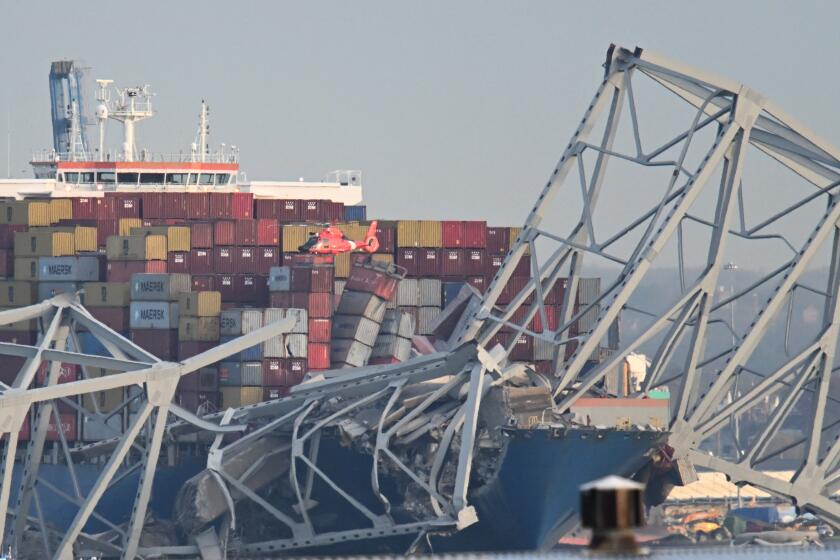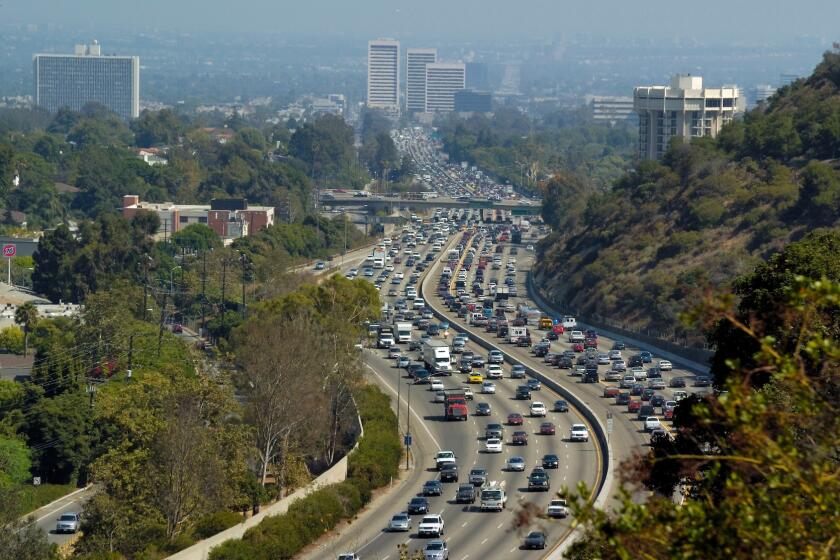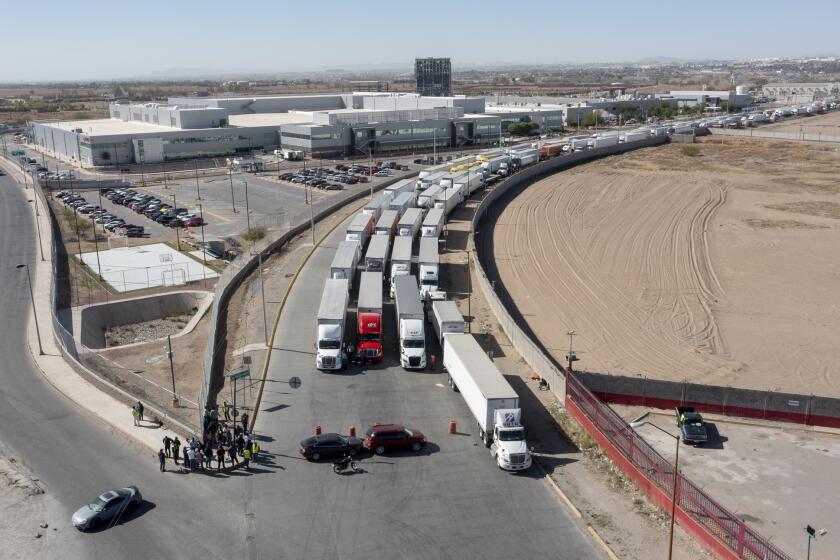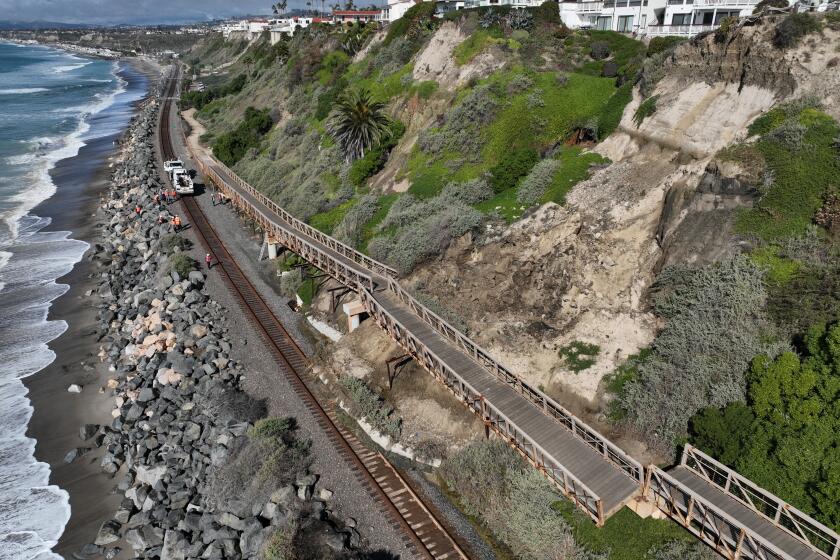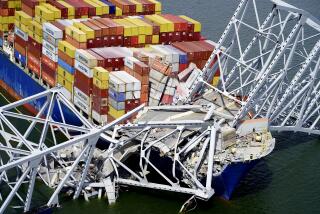Would California bridges stand up to a direct hit? We asked experts
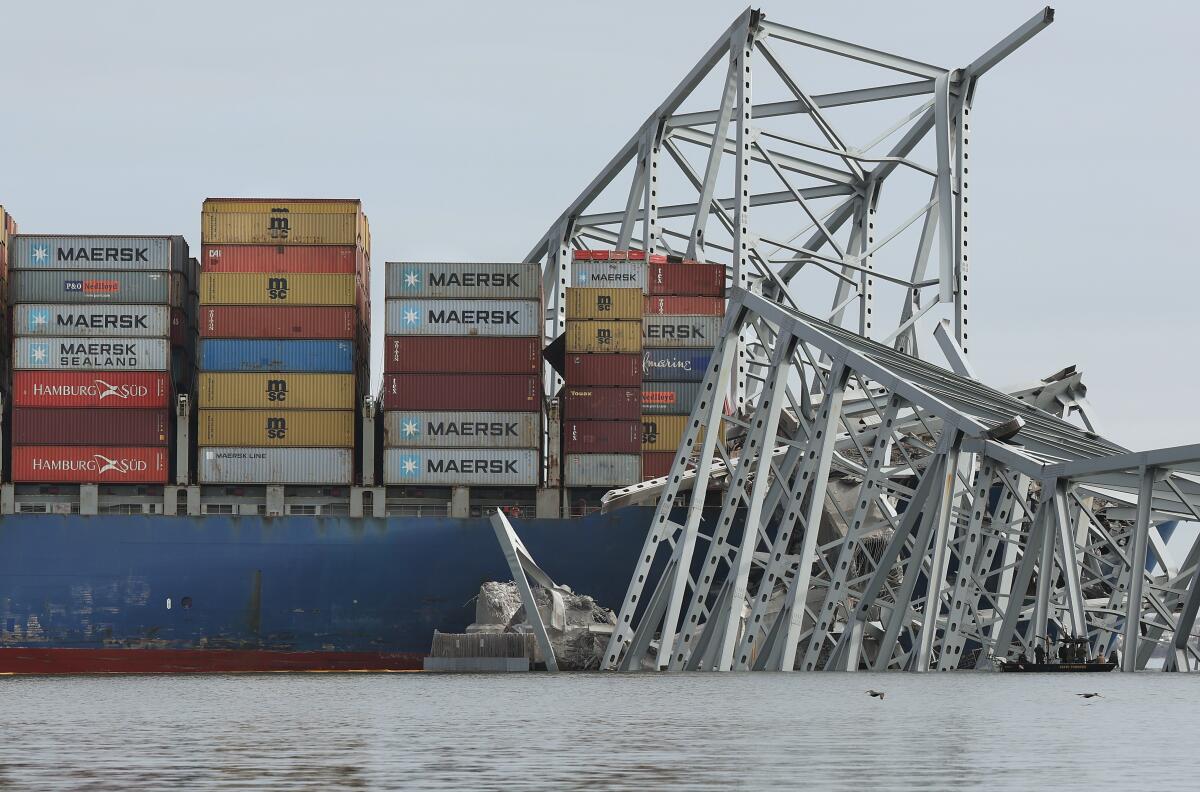
Baltimore’s Francis Scott Key Bridge stood little chance of survival Tuesday when a cargo ship rammed into it: Its vertical support structure seemed flimsy for a bridge spanning such a busy port, experts said, and did not appear to be protected by a substantial impact barrier.
Tuesday’s incident happened just before 1:30 a.m., when a 948-foot-long cargo vessel dubbed Dali lost power as it was leaving Baltimore’s port at a speed of8 knots. After the ship rammed into one of the bridge’s support piers, the structure began to shatter almost instantly.
Within seconds, the southern and central spans of the bridge began to collapse. Then the northern span. In 25 seconds, the entire bridge had plunged into the Patapsco River. Officials say six members of a construction crew working on the bridge were still unaccounted for as of Tuesday afternoon, and other victims could still be discovered.
But experts say the Baltimore collapse does not expose significant vulnerabilities in the major bridges near ports across California, which has the two busiest in the nation: the Port of Los Angeles and the Port of Long Beach, which handle about 40% of U.S. container imports from Asia. The Los Angeles port saw 1,712 vessels arrive in 2023.
Robert Dowell, an associate professor of structural engineering at San Diego State University, said California’s major bridges are less at risk of being toppled by errant cargo ships because their support columns have been retrofitted to make them withstand major earthquakes.
“If they were seismically retrofitted, they would be strengthened and you wouldn’t expect as fragile vertical members as what you saw supporting the Baltimore bridge,” Dowell said.
A major bridge in Baltimore collapsed after a container ship rammed into it, sending a construction crew and five vehicles into the river below, officials said.
California’s major bridges typically have solid supports and substantial bumpers that offer the bridge protection from a collision, Dowell said.
The Francis Scott Key Bridge, Dowell said, seemed vulnerable for a structure in such a key shipping hub. Its support pier did not appear to have a large enough bumper surrounding it, he said, and the pier itself was not one solid structure, but made up of multiple vertical members. It appears from zoomed-in video of the bridge collapse that the ship impact caused the failure of one of these vertical members first, overloading the rest of the vertical members at the one pier, resulting in the subsequent complete collapse of the main span.
Such a vertical support, Dowell said, was “a little bit unusual to be so fragile when huge ships are coming through the shipping channel.” However, even for such a fragile pier, if a proper bumper was provided around the base of the pier, it would have protected the pier from direct impact and saved the bridge, he said.
“You would think, if that’s where the large ships are supposed to go, you would have that protected, for sure,” Dowell said. “If it was a solid, reinforced concrete column ... supporting the bridge, it probably wouldn’t have collapsed in this case,” Dowell added, even without a proper bumper.
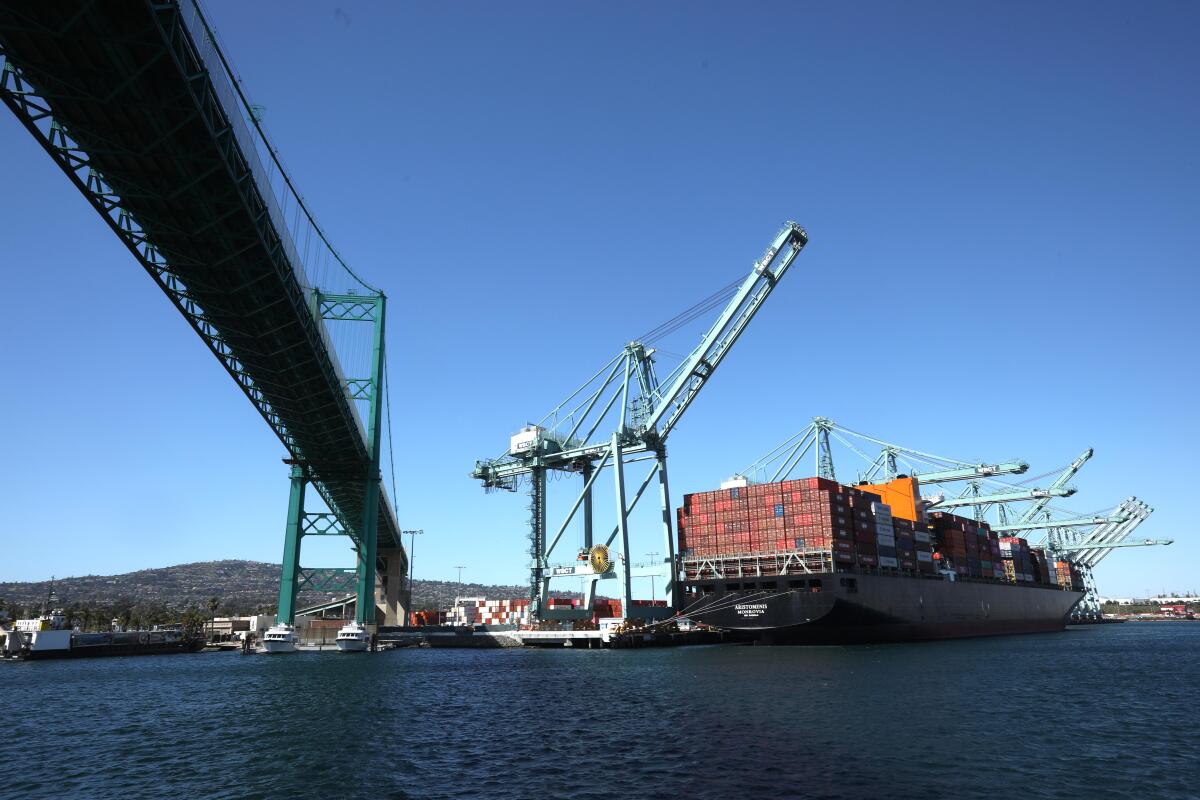
California has hundreds of steel truss bridges, but none that cross a major span of water or are located near a port.
California’s ports generally face open water, while ships must travel far inland through the Chesapeake Bay and Patapsco River to reach the Port of Baltimore.
It’s not quite fair to compare the two Southern California bridges near the state’s largest ports with the collapsed Baltimore bridge, said James Fawcett, an adjunct professor of environmental studies at USC who worked for years with the university’s Sea Grant Program, where he focused on ports and shipping.
The Vincent Thomas and Long Beach International Gateway bridges are significantly shorter than the Key bridge in Maryland, he said, and their positioning in relation to the California ports minimizes concerns about bridge damage.
“Typically, container ships can access the Port of L.A. and Port of Long Beach without ever going under a bridge,” Fawcett said.
He said the California port with the most similarities — though still hard to directly compare — would be the Port of Oakland, as most large ships there have to navigate under the Golden Gate Bridge and the San Francisco-Oakland Bay Bridge, the latter of which has multiple supports across the bay.
On Saturday, Nov. 11, a massive arson fire erupted underneath the 10 freeway in downtown Los Angeles. In the aftermath, this incident brought into focus how critical underinvestment in the state’s infrastructure could lead to a far worse outcome.
Khalid M. Mosalam, professor of civil engineering and the director of the Pacific Earthquake Engineering Research Center at UC Berkeley, said California’s focus on seismic design as it retrofitted bridges since the late 1980s and early 1990s made its bridges more resilient.
“Whether they are able to take such a huge impact, I’m not sure,” Mosalam said. “But definitely they are more robust and larger than the support I saw in some of the images.”
Installing bumpers, he said, also played a big role in minimizing damage.
“The fender system will reduce the impact for sure, because it will dissipate some of this big energy due to the impact. It’s like the shocks you have in your car when you hit a bump in the road and absorb some of this energy and you don’t feel it that big.”
In 2007, the Bay Bridge narrowly escaped major damage from a large container ship that sideswiped a pier support, leaving a gash nearly 100 feet long in the side of the ship, breaching fuel tanks that set off a major oil spill. While the spill was devastating to the bay, the 8.4-mile bridge and its stability were not affected, according to a National Transportation Safety Board report.
The collision did, however, damage the “fendering system” that surrounds the base of the support tower, which helps protect the bridge from a ship or other impact. The system was repaired, but the Metropolitan Transportation Commission, which oversees Bay Area transit, is seeking federal funds to further update and improve it, according to spokesperson John Goodwin.
He said a catastrophe like the one in Baltimore could conceivably happen in Oakland, as seen in 2007.
“A few years ago, it damn near did,” Goodwin said. “Thank heavens for the fenders we have at the Bay Bridge and elsewhere — that protected the Bay Bridge back in 2007.”
Fawcett said he was surprised, based on the videos he saw, that the container ship in Baltimore had so few tugboats helping the ship navigate through the narrow waterways.
“She apparently didn’t have adequate tugs for this situation,” Fawcett said. “It would have been wise perhaps to have more tugs assisting the vessel.”
Americans are now importing more from Mexico than China. That means more goods are coming by truck through Texas, and less cargo enters the Southland’s ports.
Cargo ships have gotten larger over the decades, with many easily weighing more than 100,000 tons.
“You would think, if that’s where the large ships are supposed to go, you would have that protected, for sure,” Dowell said.
Andy Herrmann, past president of the Structural Engineering Institute, agreed the Baltimore bridge did not appear to have a substantial buffer or enough column support to sustain a vessel crash.
“It looked like they had cylindrical piles going down, but they were not very large,” Herrmann said.
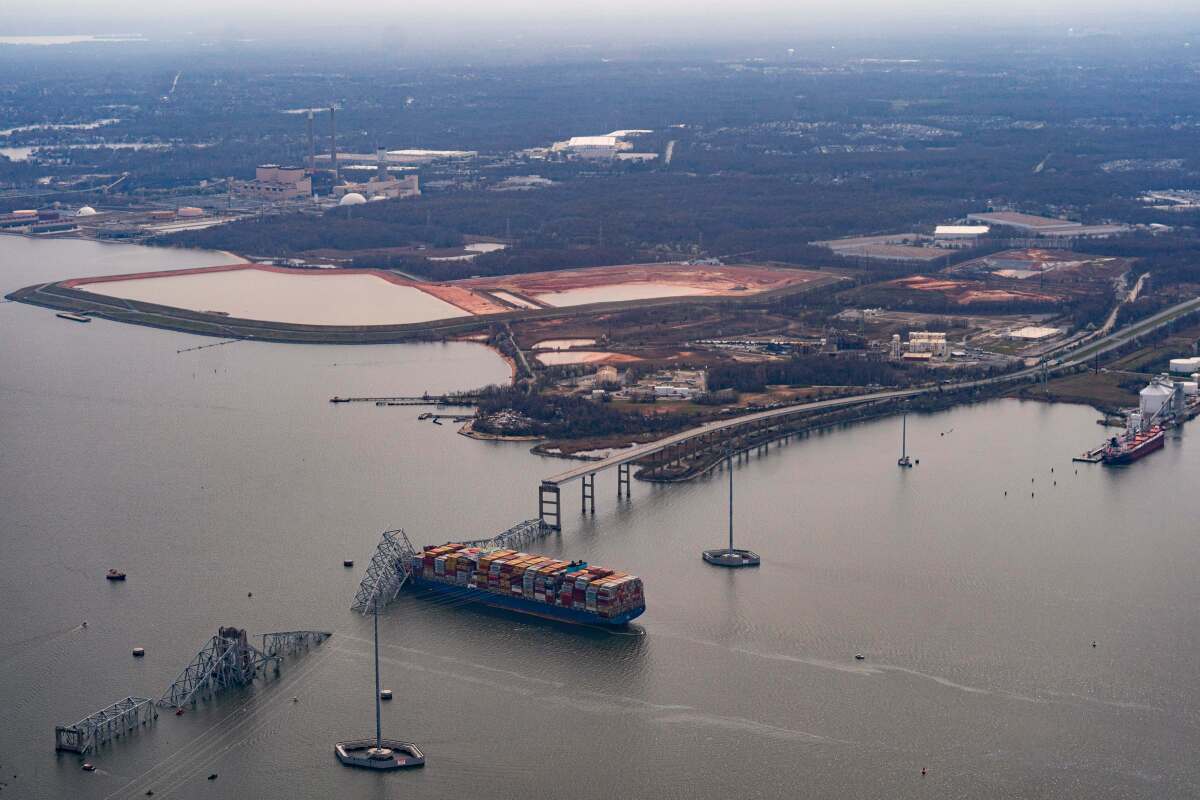
Bridge specifications changed in the 1990s to account for collisions from massive cargo vessels like the one that killed 35 people along the Sunshine Skyway Bridge in Florida in 1980.
A seagoing freighter as long as two football fields slammed into a support pier and the bridge connecting Lower Tampa Bay to St. Petersburg. The collapse plunged a Greyhound bus and seven cars into the bay.
“When they rebuilt it, they actually put an island in front of the piers, so that any shipping [vessel] that would get close to the piers, that could possibly take it down, went aground before they hit it,” Herrmann said.
The rail corridor between San Clemente and San Diego is beset by frequent closures. Perhaps it’s time to think of a better use of this coastal stretch.
For the record:
11:42 a.m. March 27, 2024In an earlier version of this article, the first name of University of Southampton professor Mehdi Kashani was misspelled as Mehni.
Mehdi Kashani, an associate professor of structural engineering at the University of Southampton in London, said such barriers have become common practice in bridge construction around the globe, ensuring that if a nearby ship veers off course, any impact still wouldn’t affect a key bridge support.
He has worked on constructing such barriers for bridges and structures along the River Thames, which connects London’s largest port to the Atlantic Ocean.
Luckily, Kashani said, retrofitting a bridge to add ship impact barriers, while costly, is possible to do without directly affecting a bridge, because the barriers can be built around existing supports.
San Francisco’s Golden Gate Bridge, despite being built in 1937, has a barrier around its south support tower, which sits on a pier mid-channel most directly in the path of ship traffic, according to Paolo Cosulich-Schwartz, the spokesperson for the Golden Gate Bridge Highway and Transportation District.
The bridge’s north tower sits partly on land, and any large ship would run aground before colliding with it, he said.
“The Golden Gate Bridge has the most robust ship collision protection of any bridge on the West Coast,” Cosulich-Schwartz said. “There’s basically a moat or buffer zone around the [south tower] pier.”
That barrier, he said, protects an area of the size of a football field with a bumper made of concrete and filled with sand.
Despite shipping containers regularly passing under the iconic bridge, Cosulich-Schwartz said that it would be highly unlikely for a wayward boat to affect it, noting that even though the barrier is from the bridge’s original construction, recent inspections have found it in good condition.
On the 30th anniversary of the Northridge temblor, Lorraine Ali recalls a city living with instability, danger and fear.
“We’re confident that the system is strong and would protect the Golden Gate in the case of an incident similar to the one we saw in Baltimore,” he said.
In Southern California, the Long Beach International Gateway — a bridge that connects Terminal Island and Long Beach near the ports of Long Beach and Los Angeles — has supports only on land, so it’s “impossible to hit that bridge,” said Capt. James Kipling Louttit, executive director of the Marine Exchange of Southern California, which provides vessel traffic services for the port.
The other nearby span, the Vincent Thomas Bridge — which connects San Pedro to Terminal Island — has supports in the water, but they are both positioned very close to land.
Times staff writer Sarah D. Wire contributed to this report.
More to Read
Sign up for Essential California
The most important California stories and recommendations in your inbox every morning.
You may occasionally receive promotional content from the Los Angeles Times.
